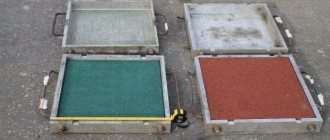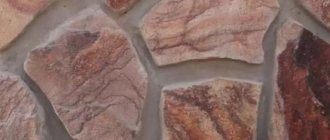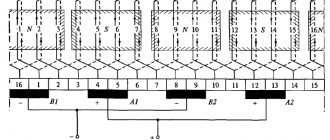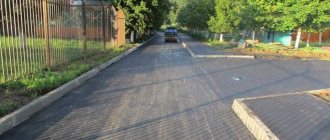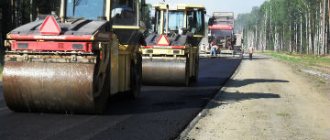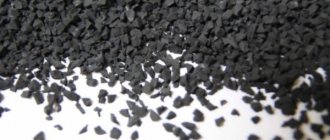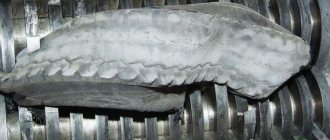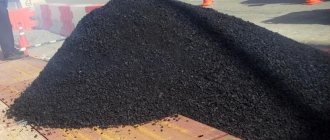Composition of asphalt crumbs
The main components of the material are gravel, crushed stone, sand and bitumen. Concrete may also be present as a binder. The ratio of components depends on the brand of asphalt, the type and condition of the road surface during removal. On average, a crumb includes:
- crushed stone - 25–45%;
- natural and artificial sand - 50–60%;
- bitumen - 3–7%.
The concentration of the latter in crumbs is less than in asphalt - the binding component leaves the coating during the operation of the road, creating the need for its repair.
Specifications
The product is a crushed road surface. It is carried out at the repair site - asphalt paving equipment includes equipment that crushes the road surface. Grinding is carried out after removal. Pieces of asphalt are sent to granulate into crushers.
The result is crumbs 3–5 mm in size, differing, depending on the production method, in the following parameters:
- The concentration of the bitumen component is that there are more binding substances in the crumbs, which are produced on site, than in the removed waste sent for recycling.
- Requirements for operating conditions - material from the road is recommended to be used in summer; it must be heated to activate the bitumen and is suitable for completely replacing the sheet. The product obtained from raw materials delivered to the production site is suitable for cold seasons. Due to the lack of binding components, it is recommended to use it to eliminate local defects.
- Price. A cubic meter of material from a cutter, on average, costs 800–1000 rubles. For a similar volume of crumbs from a crusher they charge 600–800 rubles. The cost depends on the buyer's area of residence, as it includes delivery costs.
The crumbs may include different types of asphalt - this affects the weight and other characteristics of the product. So, the mass is 1 cubic. m of crushed pavement varies between 1.5–2.0 tons. The heaviest is asphalt concrete; mixtures without cement have less weight due to the absence of fine fractions.
How best to lay asphalt chips: work order
Before laying asphalt chips, it is necessary to calculate the amount of raw materials. The calculation is carried out taking into account the purpose of the road. If you need to continue the paths in the country, you will need a depth of 3-4 cm. For 100 meters with a width of 50 cm, about 250-300 kg of material will be required. One six-ton KAMAZ truck is enough to completely asphalt the area in the yard, including access roads.
How to properly lay asphalt chips on a site in stages:
- make markings: future pedestrian paths and automobile routes are drawn on the diagram, which are then transferred to the site;
- prepare the surface: according to the markings, it is necessary to make indentations of 3-4 cm - this is the basis for the future road; the bottom is lined with boards or concrete, which will be used to strengthen the canvas;
- fill in the material: bitumen is added for better adhesion; the surface can be leveled with a rake;
- Compact the asphalt: You can rent a small vibratory compactor or use a hand-held roller tool.
Before using the new road, you must wait a day for the material to cool and set.
The given diagram of how to lay old asphalt is suitable for the yard of a private house or for paving premises. When registering a parking space, you need to take into account the weight of the vehicle. The larger the car, the thicker the asphalt layer will be.
What is asphalt crumb good for?
The material is used by industrial enterprises and individuals. Recyclable materials are included in new asphalt mixtures. Depending on the type of product (cold or hot), the waste coefficient in the new material is 0.25–0.6. That is, the share of crumbs reaches 25–60%.
The material is also used for the following works:
- local repairs - the crumb will reduce the consumption of primary asphalt when filling holes;
- preparing the base of the route;
- covering secondary and country roads with low traffic levels;
- strengthening artificial terrain - recyclable materials can be used to fill the shafts of railway and highway tracks;
- improvement of household and public areas - laying of asphalt crumbs is carried out in parking lots, country roads, sports fields and floors of technical premises.
To work with recyclable materials, you will need equipment capable of compacting and melting the bitumen into the mixture. The last procedure is not necessary - you can lay the crumbs without heat treatment - the binder will bind the particles together during the compaction process.
Technology for laying asphalt chips
The application process depends on the area of application - when strengthening the relief, the mixture is scattered in an even layer (at least 20–30 mm) and leveled with a roller tool. In the case of laying paths, the site is first marked, and soil is excavated inside the contour of the future roadbed. Crumbs are poured into the recess and then compacted. The principle remains the same when creating secondary highways and landscaping the yard.
How to lay asphalt chips with your own hands
First of all, the required volume of raw materials is calculated.
Paths made of asphalt chips in the country will require a depth of 30–40 mm. With a width of 50 cm per 100 m of coverage, you will need 0.15 cubic meters. m of material. Or 0.23–0.3 tons of product, depending on density.
With a Kamaz carrying capacity of 6 tons, one vehicle is enough (almost 2 kilometers worth of raw materials) to mark routes in the yard and fill holes behind the gates.
Work order:
- Marking - a diagram of paths is drawn, which is transferred to the territory of the site.
- Preparing the site - 30-40 mm recesses are dug in the marked contours - the basis of future paths; boards or a concrete window sill can be placed at the bottom of straight sections to strengthen the structure in loose soil. Instead, geotextile bedding can be used.
- Filling the crumbs. If you plan to melt bitumen, you will need a tin barrel and thick gloves. A rake can be used for leveling.
- Tamping. For large jobs, such as priming the road in front of a private house, a miniature skating rink is rented. Decorative and narrow paths inside the yard are compacted manually with a roller tool. Wait at least 24 hours for the material to cool or set before using a new route.
Laying asphalt chips with your own hands is easy. The presented algorithm is also suitable for improving technical premises: a barn or a garage. When creating the basis of a parking space, the weight of the vehicle is taken into account. A parquet SUV will require a thicker floor compared to a passenger model.
Technology for laying asphalt chips
This technology began to be used in road construction relatively recently, but in a short time it has fully confirmed its advantage. As mentioned above, asphalt chips are a secondary product, more precisely the result of multi-layer removal of the old road surface followed by crushing. Despite the low cost of production, the material is distinguished by its significant strength and can be processed.
One of the main advantages of this material is considered by many to be the ability to densely fill all voids and cracks in the coating. Even with time and gradual compaction with the help of cars, such a coating only becomes stronger and more durable. Due to the dense laying, the road is practically not subject to erosion.
Working with such material is incredibly simple; the main thing is to know the basic cycle and laying technology, which includes several successive stages:
- The first thing to do is to clear the masonry area as efficiently as possible, and then lay the so-called “cushion”. In each specific case, it may differ depending on the specification of the future road. For example, you can use crushed stone, concrete or broken brick. In some cases, it is justified to lay several layers of the listed materials.
- After this, the surface must be carefully leveled using special road equipment.
- Next, pour out the material of the future coating and level it over the entire plane.
- The last stage includes compaction with rollers. After all the above stages, the road is ready for use.
Note: here it is necessary to note the peculiarity that for such coatings it is not recommended to use rollers weighing more than 10 tons. And if you pre-fill the canvas with bitumen, you can achieve better strength and impermeability of the coating.
Considering the main advantage of such a material, such as low cost, more and more people are filling the roads in their areas with crumbs. In addition, it is gradually replacing classic materials, such as paving slabs and paving stones, used for arranging playgrounds and park areas.
Read on topic: Which minibus is better to buy for work
When installing yourself manually, you need to similarly maintain the technology and stages of work in order to achieve a positive result.
Note: pay special attention to the route of communications. Take into account the fact that sooner or later you will have to change pipes and the like, which will accordingly lead to the destruction of the canvas.
When we have determined the size of the plot, we order about 10-12 tons of asphalt chips per 100 square meters. Consider the amount of work. If the area is really large, it is better to rent a small skating rink. As a rule, the factory selling the material will be happy to lend its equipment for use, of course for an additional fee.
When the material is ordered, you can begin preparing the site, namely removing the top layer of soil. Keep in mind that you will have to remove at least 20 cm. As a result, a characteristic trench will form. If desired, you can put a layer of geotextile on the bottom, it will prevent soil subsidence.
A mound (cushion) of crushed stone and sand is laid on top of the geotextile or earth. Each layer is at least 3-5 cm. In principle, if high pressure is not planned for the area, you can do without these materials.
Note: the volume of soil is large, so take care of removing the soil in advance.
After all the preparatory work, you can safely start pouring the crumbs; this must be done sequentially. For convenience, you should get a couple of assistants, because it will be difficult to cope with such a volume of work alone. The crumbs are poured out in small “batches” to avoid the formation of voids. If the area is large, it is better to use a roller. There is nothing complicated in managing it, but at the same time you will save a lot of time and effort. To achieve coating strength, bitumen emulsion should be applied first. Thanks to bitumen, it will only be stronger and will also become resistant to temperature changes during the cold period.
Read on topic: Production of sand asphalt
The technology for laying on roadsides and ramps is identical and is carried out according to the same scheme. The material is considered the best alternative to crushed stone and sand, but in comparison with the classic coating it does not have enough strength; after all, the crumb is loose in structure.
Pros and cons of using asphalt crumbs
Reducing the burden on the environment and utilities is one of the main advantages of the material. Lining with recycled materials leads to less use of gravel and bitumen, products from the mining and oil refining industries. The advantages of the decision to lay asphalt chips also include:
- pavement strength - a mixture from the highway will ensure the strength of your home driveway;
- weather resistance;
- aesthetic appearance - combines the external characteristics of gravel and asphalt pavement.
Disadvantages of the product are considered to be color changes caused by weathering on the coating and inconsistent quality. The crumb composition can include different types of asphalt: from the classic mixture to concrete and sand variations. This makes it difficult to determine the final characteristics of the product. Residual traces of spills of oil, acid or other aggressive substances that occurred during the operation of the track can affect the health of users of the track made from recycled materials.
Reviews
Users rate the material positively. Reviews show that recyclable materials are suitable for designing passenger transport routes. Quotes taken from reputable construction forums.
Leonid: “Trucks left ruts on the crumb road, especially in the summer. The material is perfect for passenger cars - we filled it up 5 years ago until we observed any chipping or pushing through.”
Oksana: “We used it to design paths between the beds. There are no complaints - it doesn’t slip, doesn’t retain rainwater, doesn’t crack in the cold and looks neat.”
Mikhail: “We thought about buying crushed stone, but crushed asphalt was almost 2 times cheaper - the highway was being repaired next to the site. It falls asleep and compacts easily; after 2 years there are no complaints.”
Asphalt crumbs are useful recyclable materials. The material is used in various industries and is suitable for landscape design. With its help, durable courtyard paths and public routes with low traffic flow are created.
